Results 11 to 20 of 257
-
05-30-2014, 02:48 AM #11
Y Axis
Y AXIS
Similar to what I did on the X axis belt, I wrapped the Y axis belt around some aluminum spacers and doubled up on the zip ties. I used 3/8-inch long aluminum spacers, filling the remaining gap in the mounting brackets with two flat washers placed on the side opposite from where the two washers were put on the Y - idler. Washers were put on opposite sides because of the mysterious offset between the brackets on the Y-bed and the brackets on the Y-idler. I ended up with a belt approximately 26-1/4 inches between holes in the two aluminum spacers.
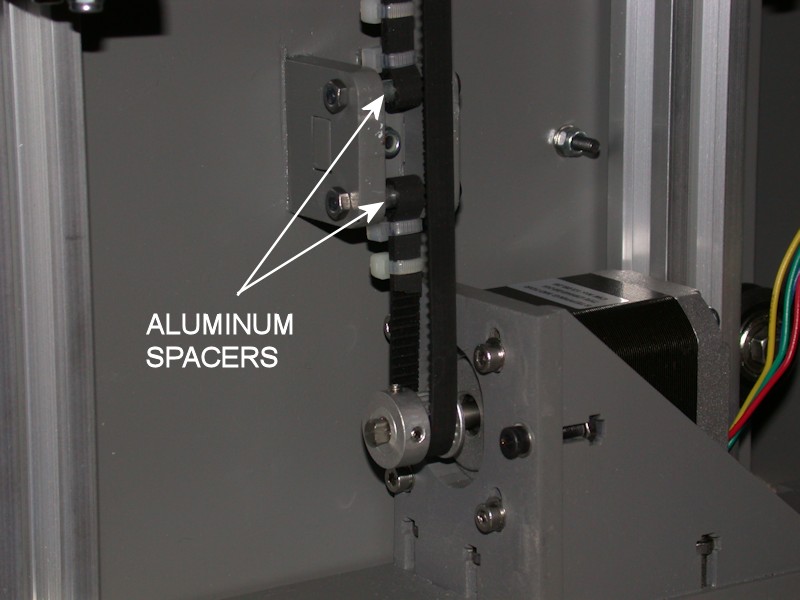
FOLLOWUP COMMENT #1: In adjusting the Y endstop switch, I determined that the uppermost zip tie in the picture had to be moved closer to the aluminum spacer belt mount. As shown here, that zip tie would catch on the bracket holding the Y idler at the front of the printer. I also trimmed back the excess belt to make sure it didn't reach to the bearings in the Y idler. Until the printer was in final assembly, I didn't realize how far forward the Y bed travels.
FOLLOWUP COMMENT #2: The Y axis build video doesn't involve the Y idler in the belt alignment. I suggest first sliding the Y bed forward and adjusting the end loops on the Y bed bracket so they line up with the belt centered on the Y idler. The brackets on the Y bed don't line up well with the brackets on the Y idler, so you'll likely find the belt rides all the way to what will be the right side when the printer is upright. Then slide the bed rearward and adjust the gear on the motor to align with the end loops on the Y bed as done in the video. Slide the Y bed back and forth; try tweaking things if the belt tends to rub on the Y idler brackets.
FOLLOWUP COMMENT #3: Use of an idler pulley on the y-axis idler bearings would obviously help keep the y-belt from rubbing against the idler bracket. My improved version of one is available at http://www.thingiverse.com/thing:790138. My approach to an alternate method of attaching the belt to the y-bed is available at http://www.thingiverse.com/thing:796250.Last edited by printbus; 05-31-2015 at 08:24 AM. Reason: added mention of idler pulley and alternate belt attachment
-
05-30-2014, 02:53 AM #12
LCD assembly and installation
LCD INTERFACE and LCD INSTALLATION
I didn't like the way the build videos clamp down on the display board and bend it. To prevent this from happening, I used some 3/16-inch long spacers between the display board and the LCD bracket. The spacers really can't be any longer than this or the LCD bracket end will start to interfere with the SD card slot.
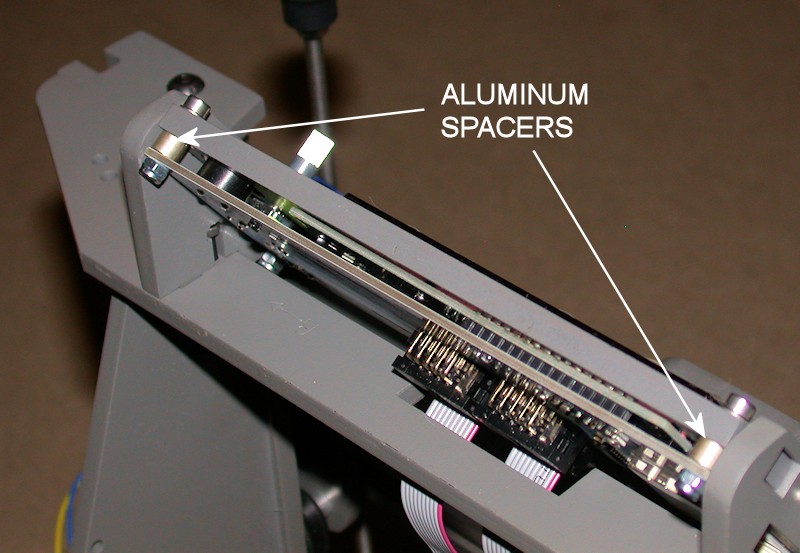
FOLLOWUP COMMENT #1: I've had several cases where the display either blanks out or displays random garbage after I first touch the encoder shaft or the metal knob I had installed on the shaft. There might be a static discharge issue here, so I replaced the metal knob with a printed knob to see whether the problem goes away with an insulated one. A better knob was later found on Thingiverse and used instead.

FOLLOWUP COMMENT #2: The buzzer on the LCD is quite loud. I tamed mine down by covering the hole in the front of the buzzer with a small piece of black electrical tape.
FOLLOWUP COMMENT #3: The display comes preassembled with one row of soldered pins fastening the two boards together. At some print speeds, I've had the LCD board vibrate against the larger board and/or vibrate against the wood frame. To fix this, I added a few dabs of hot glue between the two boards, opposite from the row of soldered pins. Double-sided foam tape or something similar could also be used to improve how the two boards are fastened together.
FOLLOWUP COMMENT #4: There were additional rattles coming from the LCD vibrating in the wood frame. Narrow strips of electrical tape were added as a cushion to either the wood, the circuit boards, or the metal frame on the LCD so that no two hard surfaces can vibrate.Last edited by printbus; 05-03-2015 at 12:00 AM. Reason: migrated to offsite image storage due to 3DPrintBoard issues
-
05-30-2014, 03:02 AM #13
Z Motor
Z MOTOR
I don't want wires extending off the sides of the printer, so the Z motors were oriented with the wires exiting the motors to the rear. The wires will likely eventually be routed through holes added to the frame beside the aluminum rails.
Consideration was given to using M5 coupler nuts at the threaded rod nut brackets. These would be long enough that they stick out of the brackets, allowing the nuts to be bonded to the brackets and/or aluminum rails with hot glue or other adhesive. I opted to not do this, but I'll put in the coupler nuts if I see issues with the standard nuts being loose in the brackets.
FOLLOWUP COMMENT: I'm sure the nuts are loosely held in the nut brackets as a safety measure. If the X-axis is lowered too far and the extruder hits the print bed, having the nuts loose will simply cause them to pull out of the nut brackets instead of damaging the extruder, the print bed, or binding up the Z-motors. That would be something to consider before bonding the nuts into the brackets.
Flexible 5mm x 5mm shaft couplers purchased from MakerFarm were used to attach the threaded rods to the Z motors instead of the plastic tubing. Normal thread specifications allow some fit tolerance, so the threaded rods are a bit less than 5mm diameter. To improve the coupler grip on the threaded rods, I added a single layer of metal adhesive tape to the rods. I used some copper shielding tape I had, but something like foil HVAC tape should work as well. Regular foil would work too, but the adhesive backing is handy during installation. Anything metal will likely hold up better to the rod threads than vinyl tape, etc. In other threads, I've suggested wrapping the threads with the right gauge wire as a means to thicken up the rods. That sounded like a good idea at the time, but I didn't have much luck with that. In another thread, Old Man Emu pointed out there's another coupler design that uses grub screws to hold the shafts. They're probably the best way to go. Use of these couplers does require a ball-end 3mm driver to be used with the stock location of the Z endstop switch.
FOLLOWUP COMMENT: After using the printer a few months, I definitely suggest looking for the flexible shaft couplers with a pair of set screws to hold the shafts instead of this clamping style. While I didn't observe any issues in the printing quality, I did notice one of the threaded Z-rods was no longer tightly clamped in the coupler. I ended up tapping both of my couplers for an additional set screw on each shaft. It sort of boils down to "buy it right or buy it twice." More info on this is available in TWEAKS TO THE COUPLERS ON THE Z-AXIS RODS.
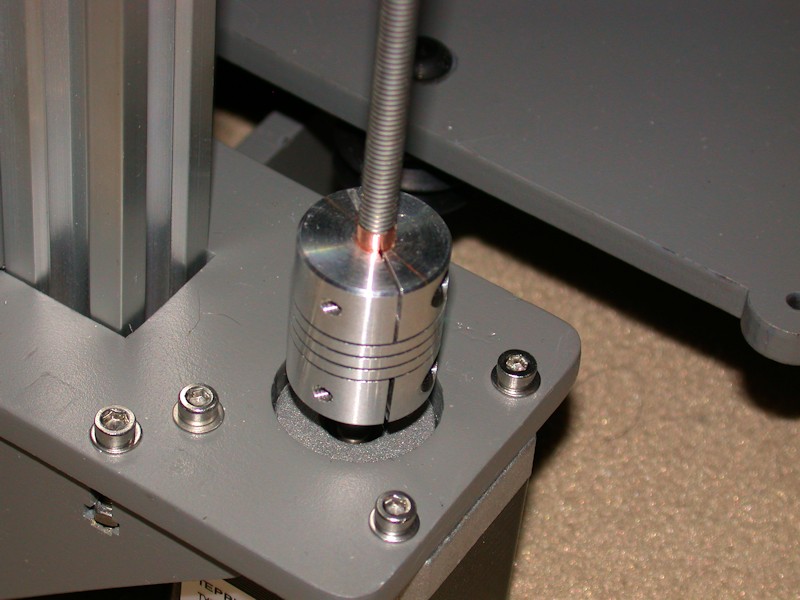
I added threaded knobs to the top of the Z rods. I felt there's a bit of an eye safety issue in having the top ends of the rods exposed, and preferred the appearance of actual knobs over wing nuts. The knobs I used are Grainger 3GFJ3. The knob on the left might get in the way of the provided top-side spool mount if I use it. I'll deal with that when it becomes a problem.
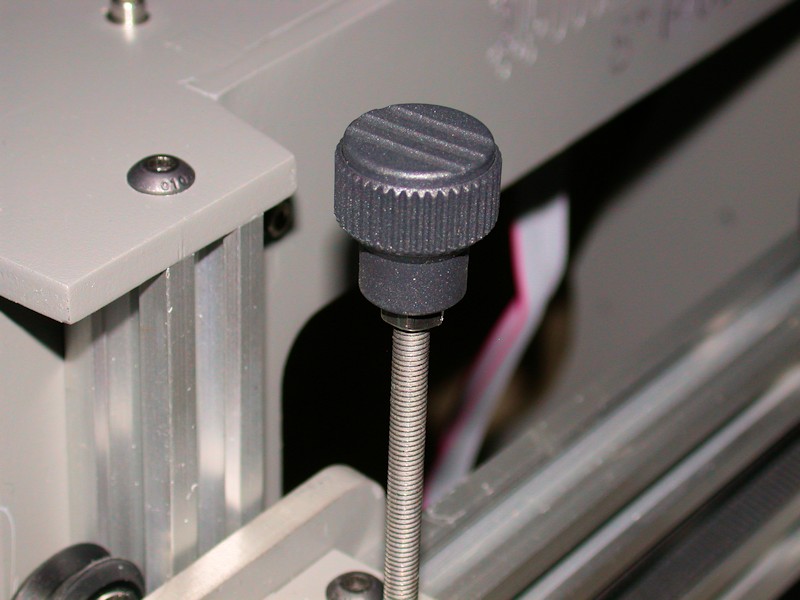
FOLLOWUP COMMENT: After I could raise the X axis to the top and check for clearance using the Z motors, I lowered the knobs as far as I could both for appearance and for minimizing conflict with the stock spool mount. I'm only losing usable height of about the thickness of the jam nuts under the knobs.Last edited by printbus; 05-03-2015 at 12:03 AM. Reason: migrated to offsite image storage due to 3DPrintBoard issues
-
05-31-2014, 02:30 PM #14
Thermistor Build
THERMISTOR BUILD
Cutting the small high temp sleeving tends to collapse the sleeving, making it hard to slip onto the thermistor wires. I found opening the cut end of the sleeving with a stick pin was helpful.
I ended up shortening the sleeving and thermistor leads for the hot end.Last edited by printbus; 08-10-2014 at 11:40 PM.
-
05-31-2014, 02:50 PM #15
Heat Bed Installation
HEAT BED INSTALLATION
The MK1 heat bed has circuit pads for an LED and current limit resistor(s), and I opted to take advantage of that. The LED will face the rear of the printer, but I like the idea of having a visual indicator that there is in fact power being applied to the heat bed. I didn't have surface mount components on hand, so I tacked on a leaded-type T1 LED and 1K resistor. I also replaced the power wires on the MK1 with 18 gauge flexible silicone wiring. In addition to being very flexible, the high strand count of the wire will hold up better. Another trick from my RC helicopter hobby.
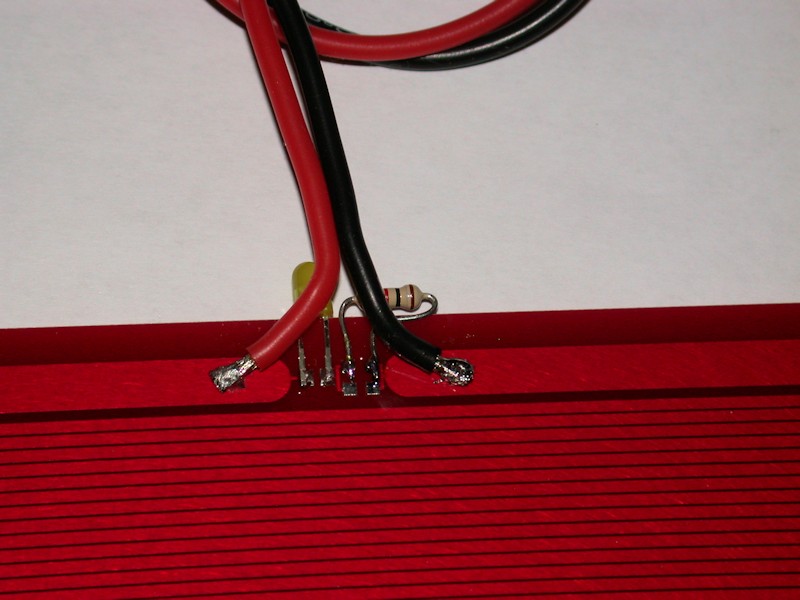
As an insulator between the Y bed and the heat bed, I picked up an 8-inch (200mm) square silicone pot holder/trivet from eBay to try. It's a perfect fit for the heat bed. This has a mesh pattern on both sides, and I trimmed away some of the mesh ribbing on one side to clear the bolt heads on the top of the Y bed. The silicone pad is thicker than what the typical piece of cardboard or cork sheet would be, so I had to increase the nylon spacer in the rear right corner to 3/8-inch. 3/8 of an inch might still be a bit short. I'll convert over to cardboard or cork if I end up needing that printable height loss back at some point.
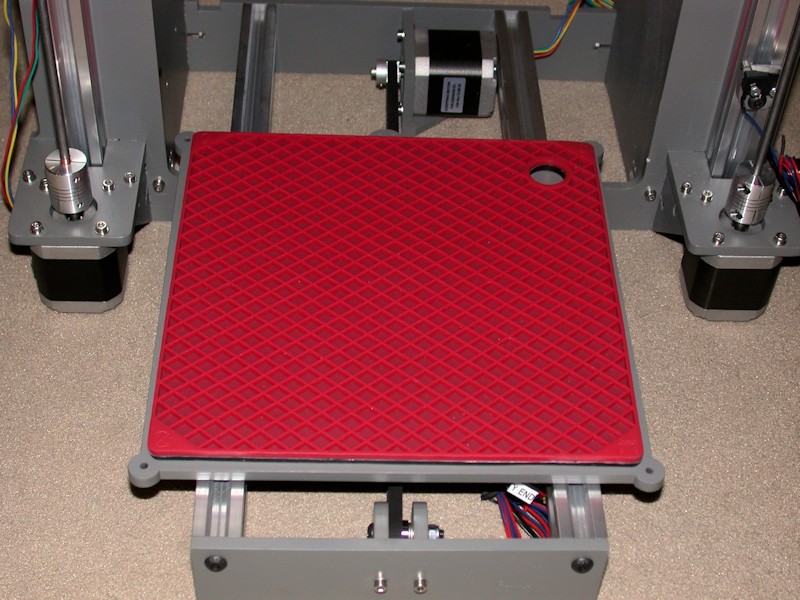
FOLLOWUP COMMENT #1: In the later post on BED LEVELING, I describe how I revamped the approach to mount the heat bed to the Y bed. All four corners are now equipped with a spring. Longer and fully threaded M3 x 30mm bolts were used and a locknut is used to fix the bolt to the heat bed. Thumbwheels used on the bolts extending through the Y bed to provide a fast, tool-free means of adjustment.
FOLLOWUP COMMENT #2: For a printing surface, I had the local Ace Hardware cut some 1/8-inch glass to 8-3/8 inches square, roughly the same size as the heat bed. They wouldn't cut the angled corners needed to clear the mounting bolts, so I used a wet tile saw with a diamond blade to carefully cut them. I figured if the tile saw can cut glass embedded in mosaic tile, it would likely cut the glass better than I could do with a scribe. A bit of effort with a sanding block softened up the edges around the entire glass plate.
FOLLOWUP COMMENT #3: After using the printer a while, I realized the binder clips used to clamp the glass print surface to the heat bed rub on the heater traces on the bottom side of the heat bed. While I've never heard of anyone reporting wearing through the protection on the heat bed and shorting trace loops with metal binder clips, next time I have the heat bed assembly apart I'm going to add some kapton tape along the bottom sides of the heat bed as an extra precaution.
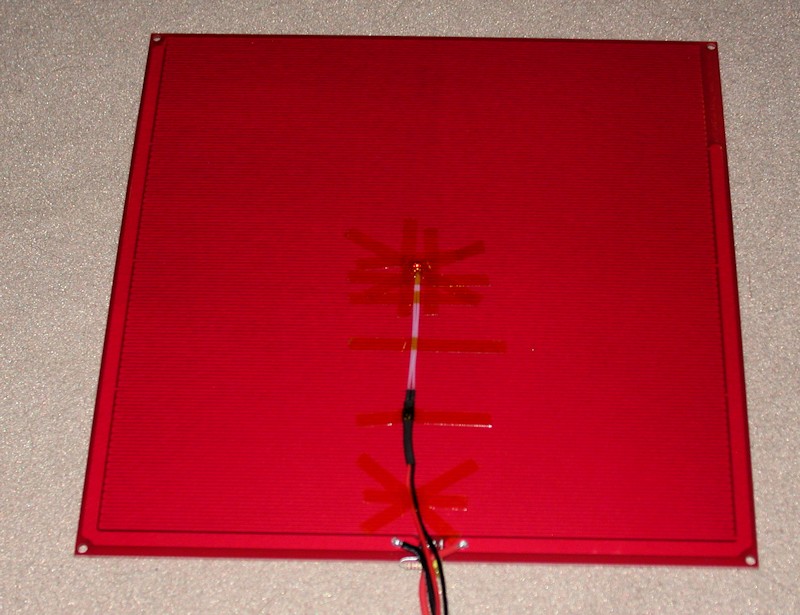
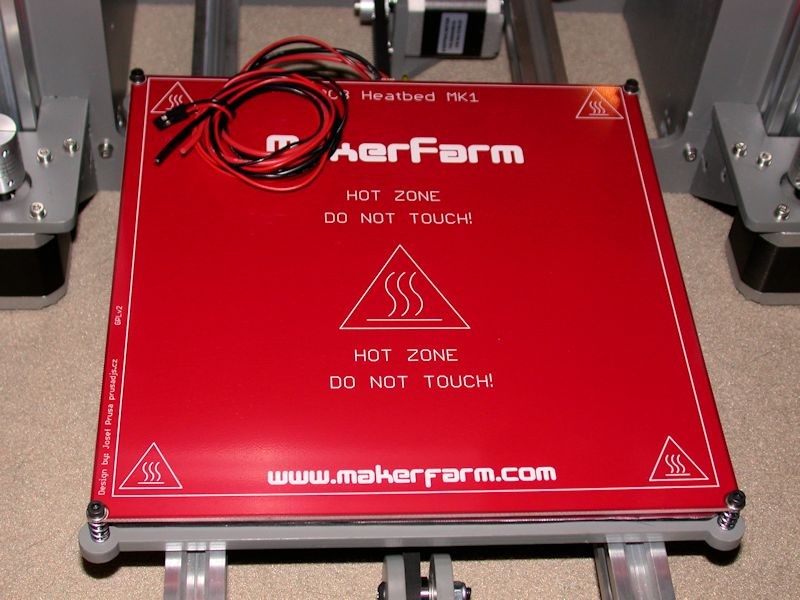
Last edited by printbus; 05-03-2015 at 07:43 AM. Reason: migrated to offsite image storage due to 3DPrintBoard issues
-
05-31-2014, 03:14 PM #16
ENDSTOP INSTALLATION
To provide a more permanent endstop setting, I wanted to use bolts and nuts to attach the switches to the endstop brackets instead of zip ties. Holes in the switches are sized for M2.5 hardware. So that the bolt heads wouldn't interfere with the aluminum rails on the back side of the brackets, I used a 3/16-inch drill bit to countersink the M2.5 screw heads. This allows the brackets to mount flush to the rails - another advantage over the zip ties. M2.5 x 12mm screws worked well for mounting the switches. As a good practice, heatshrink was used on the wire connections at the switches. For now, I left the unused red wire in the end stop cables. I assume the RAMPS board puts something like 5V on that wire, which isn't needed in the i3v. Since I plan to sleeve wire bundles wherever I can, I wanted to retain this for future use should I want to upgrade to optical sensors, add lights, etc. Heatshrink was added to cover the ends of the red wire and the wire will be folded over inside the sleeving when I get that far.
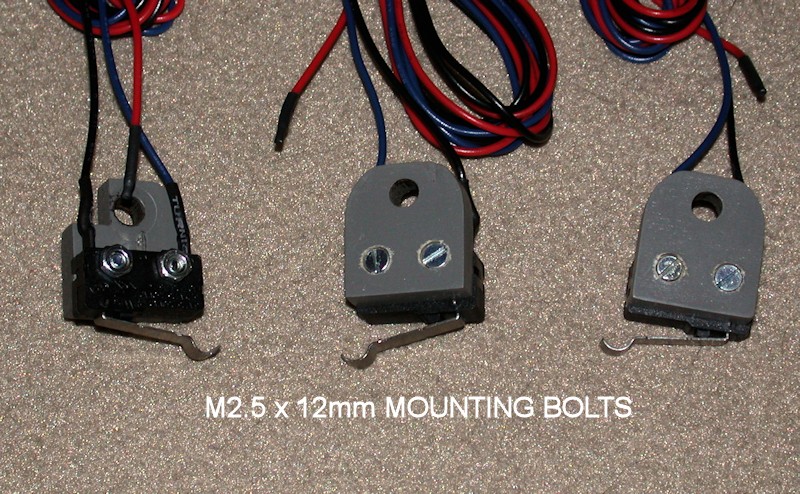
To improve how the Y bed hits the Y endstop switch, the M3 bolt on the Y bed was replaced with a 6-32 bolt and threaded aluminum spacer 1-inch long.
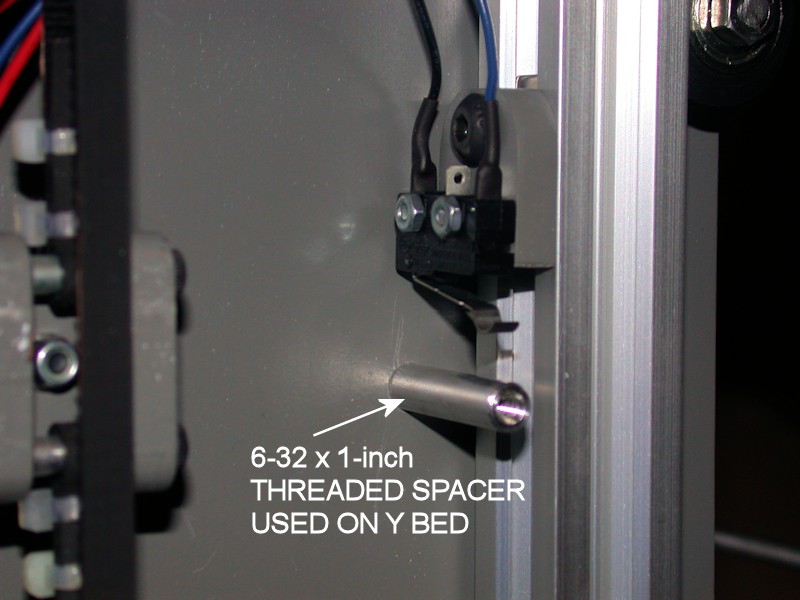
Since I was already weakening the Z-stop bracket slightly by countersinking the bolt heads, I didn't want to shave material off the back side of the mounting bracket as done in the build video. Instead, I glued a small piece of wood scrap from the kit's plywood sheets to the X idler. This gives a good surface area for the Z endstop switch to hit - it's probably a better fix than shaving off the back of the endstop plate anyway. At some point, I may decide to add a similar wood piece to the X carriage for the X end stop.
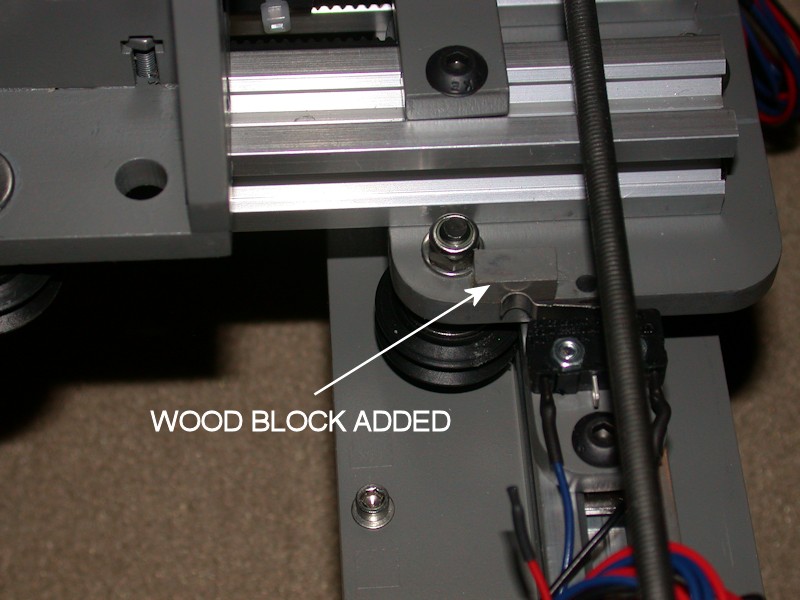
NOTE: Switch locations in the photos are not final. They'll be adjusted later.
FOLLOWUP COMMENT #1: The unused red wires got pulled out of the connectors for the endstop switches fairly quick. They were just getting in the way.
FOLLOWUP COMMENT #2: In the later WIRE ROUTING (PART 2) post, I relocate the X endstop switch to the bottom of the lower aluminum rail. This requires the switch to mounted on the reverse side of the switch bracket from what is shown in the picture. I also later increased the length of the notch in the switch bracket so that it could slide farther past the nut on the wheel bolt. The small wood block added to the X idler extends farther towards the wheel bolt than it needed to. I got very lucky here. When I moved the X endstop switch to the bottom of the lower extrusion, that small block almost got in the way. I should have kept it shorter.
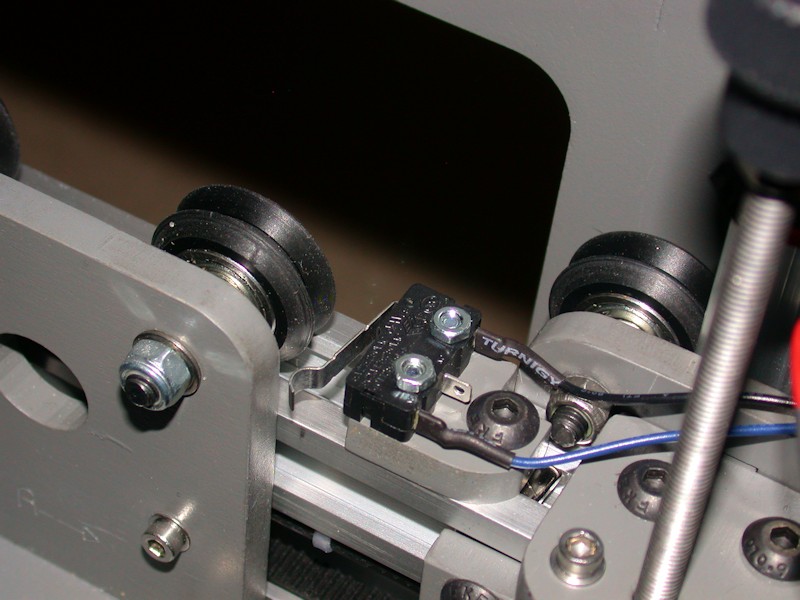
FOLLOWUP COMMENT #3: Clough42 has several upgrades for the i3v available on Thingiverse, including endstop switch brackets designed to fit the V-groove of the aluminum rail. I found the MakerFarm approach for the Z endstop especially lacking. Clough42 has a great improvement that provides a screw-based Z endstop adjustment. This eliminates the reason for adding the small wood block or shaving off the back of the Z endstop bracket.
FOLLOWUP COMMENT #4: Those clough42 switch brackets only work with the 8-inch printer. There's a similar solution for the 10-inch printer from another user on Thingiverse.Last edited by printbus; 05-03-2015 at 12:14 AM. Reason: migrated to offsite image storage due to 3DPrintBoard issues
-
05-31-2014, 03:48 PM #17
Extruder and Hexagon Hot End
EXTRUDER AND HEXAGON HOT END
Before I added the extruder assembly to the printer, I opted to add some lighting to the X Carriage. There's a perfect area underneath it for mounting some adhesive strip LED lighting. I used two sections of 12V warm white LED strip lighting that I had leftover from a prior artwork project. A two-pin header was added to the sidewall of the X carriage extruder bracket for use as a connector on the LED wires. I thought about just tying the LEDs into the extruder fan power, but decided to run dedicated lighting wires in case I want to put the LEDs on a switch or dimmer circuit. I plan to sleeve the bundle of wires leading to the extruder assembly, and having a connector on the LED wires will allow me to disconnect the LEDs when I remove the extruder and cable harness from the X carriage for repair or cleaning.
FOLLOWUP COMMENT: A picture showing the heat bed illumination from these LEDs is here.
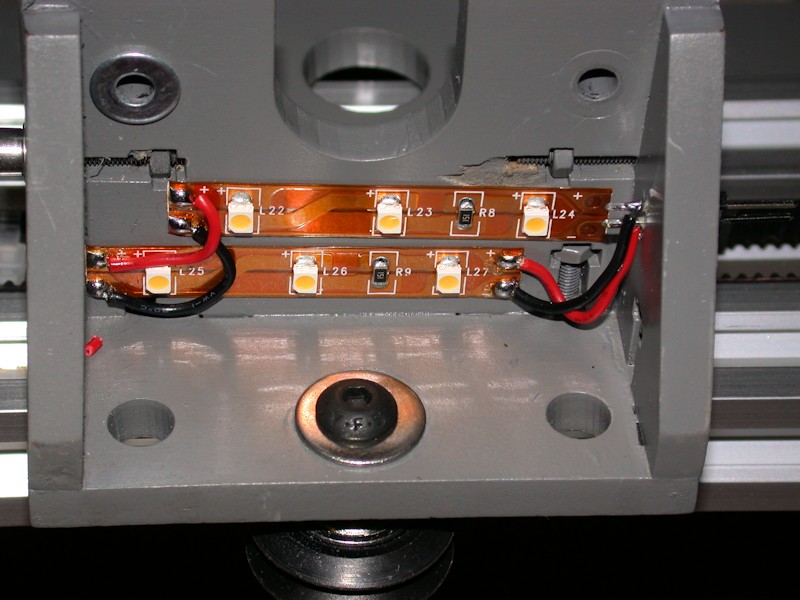
A locknut was used instead of the provided standard nut on the filament release pivot bolt. My printed parts seemed to have a looser fit than those in the build videos. After assembling everything I was disappointed to find a lot of sloppy mechanical play in the extruder tip. Multiple things were done to fix this. To improve how the bearings fit in the extruder, I added a layer or two of kapton tape around them. To minimize slop in how the hobbed bolt fits in the bearings, I added three or four turns of tape to the bolt where the bearings ride. The hex hot end was also a very loose fit in the aluminum mounting plate, so I added a layer of kapton tape to the post of the hex hot end. After final assembly, the extruder tip now has zero play.
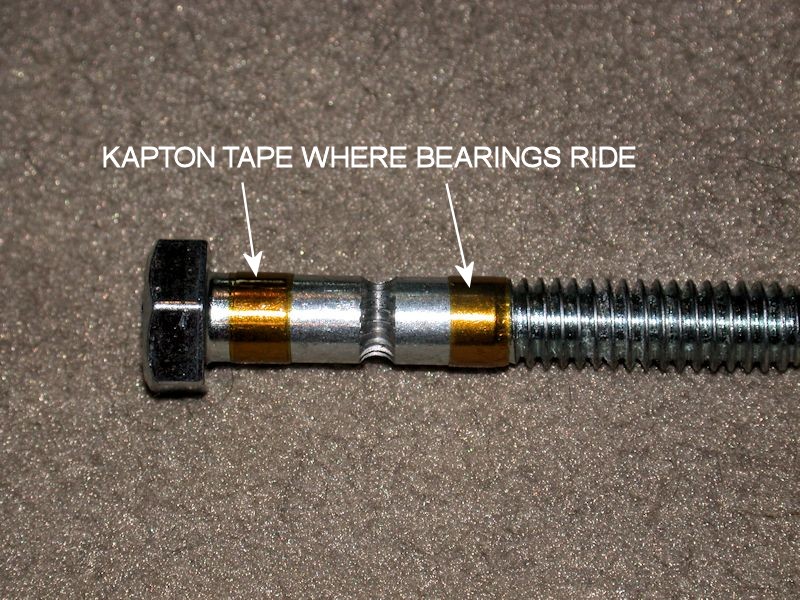
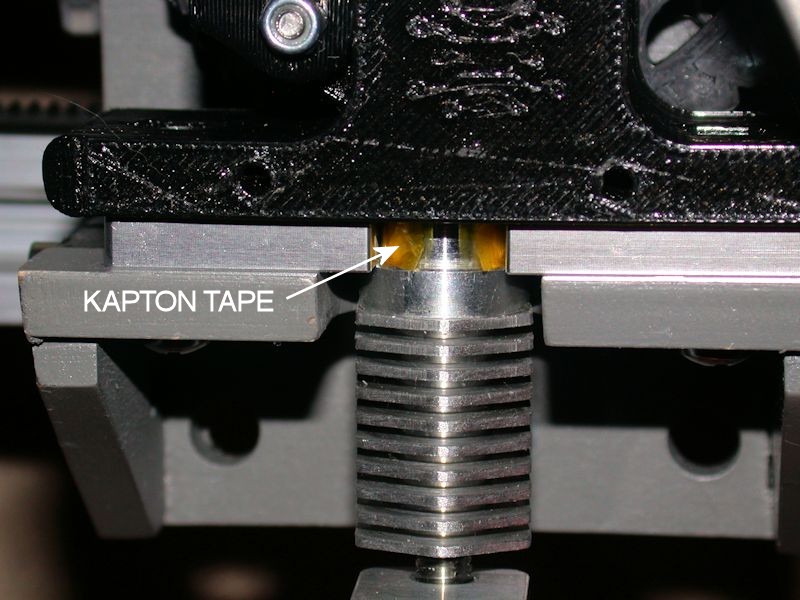
Envisioning how I plan to route wires, I oriented the extruder motor so the wires exit differently than shown in the build video. I found it necessary to lengthen the elongated motor mounting holes in order to obtain good gear mesh, at least with the gears in new and unused condition. M3 x 16mm bolts and M3 fender washers were used on the extruder motor instead of the provided shorter ones that are intended to recess into the wall of the extruder. The face-mounted fender washers should improve the hold as heat from the extruder motor starts to soak through the motor mount. Watch for conflict between the left motor mounting screw and the large gear; use of a button head screw will help reduce the size of the screw head.
The build video discusses the user printing a fan shroud for use with the hexagon hot end. A shroud was included with the hex hot end I ordered with my i3v. I found it challenging to add the shroud and fan on the bench with the hot end and aluminum plate still loose. I ended up mounting the extruder and hot end to the printer and then installing the fan and shroud. I had to enlarge the holes in the shroud for M3 bolts to pass through it.
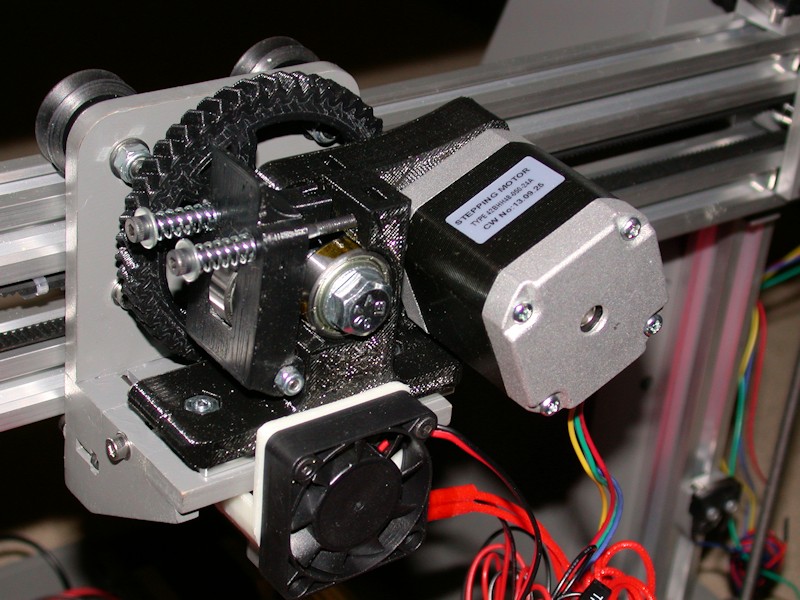
FOLLOWUP COMMENT #1 - I later realized that since I had added more washers than usual under the large gear to clear my face-tightened motor mounted screws, the large extruder gear was now rubbing against the ends of the bolts for the top two wheels on the X carriage. I ended up fixing this by shortening the bolts with a file so they don't protrude from the lock nuts when they are installed.
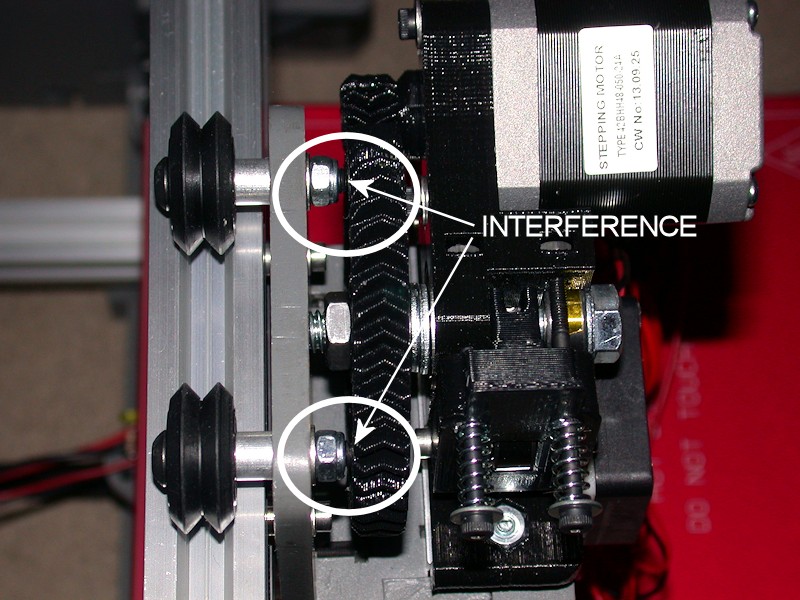
FOLLOWUP COMMENT #2 - I applied it later in the assembly, but I followed the ZennmasterM recommendation of using Permatex Muffler & Tailpipe sealer to thermally bond the thermistor to the hexagon hot end. ZennmasterM's use of a syringe would be overkill for the hexagon front end; all I did is dab a bit of it into the dimple provided for the thermistor with a straightened paper clip. After all my wire and cable routing was complete, I redid the kapton tape over the heater and thermistor wires. With wire movement now fairly over, this is when I applied the Permatex sealer.
FOLLOWUP COMMENT #3 - In response to some suggestions I found elsewhere on the web, I've reversed the hot end fan so that it is pulling heat away from the hot end and exhausting it out the front of the printer. This reportedly works better than pushing cool air into the "boxed in" bottom part of the i3v X carriage.
FOLLOWUP COMMENT #4 - The stock shroud for the hex hot end is mounted with the two screws for the hot end cooling fan. The shroud also sort of snaps onto the aluminum barrel of the hot end. I'm not sure what the intent is since that causes the bottom of the shroud to melt where it touches the aluminum block of the hot end. I've subsequently printed the shroud in ABS and cut away the bottom of shroud so it just barely clears the aluminum block of the hot end. This has eliminated the problem with the shroud melting. Having the shroud only supported at the top led to an occasional vibration at some print speeds. This was fixed by adding a silicone isolator between the shroud and the fan.
FOLLOWUP COMMENT #5 - The stock extruder comes with #6 Phillips head screws for mounting to the X-carriage, with nuts that are recessed into the printed extruder base. I replaced the #6 hardware with M4 cap screws, long enough that fender washers and nyloc nuts can be used on the face of the extruder base. I used M4 x 25mm. Cap screws are easier to tighten than Phillips head. Using fender washers on the face provides a lot more surface area that should hold up better to any heat making it's way up from the hot end. Using nyloc nuts should help keep the hardware tight. The screw on the left side can accept a very large washer; I used a 3/16-inch ID washer there that is about 20mm in diameter, just about the same width as the base of the extruder. It's tricky to get the nylock nuts in place, but my hope is that this improved mounting method leads to messing with the mounting hardware less often.
FOLLOWUP COMMENT #6 - Some have had issues with the adhesive backing not holding on similar LED strips. Mine have held fine. I'm not sure if it is the fact that the LED strips I have used 3M branded adhesive or the nature of the painted surface. Adding the kapton tape to the aluminum u-channel has been tricky. In subsequent extruder rebuilds, I've been adding layers of kapton tape as required to the top, round end of the hot end, using the tape as a spacer to push the hot end down into the aluminum bracket.Last edited by printbus; 05-03-2015 at 12:21 AM. Reason: migrated to offsite image storage due to 3DPrintBoard issues
-
06-01-2014, 02:45 AM #18
Every time I look at this build thread, I am impressed by the appearance of the printer. It really is competitive with those unbox, plug in, print ones in aesthetic appeal. If it prints like the original i3 it's a real winner.
OME
-
06-01-2014, 09:00 AM #19
Thanks, OME! You're grasping where I'm trying to head with this build. Yeah I've ran into a few minor things, but I'm still pretty happy with the i3v design - I see no reason why it shouldn't be a great printer. I'm futzing around with the build more than I thought I would, but I'm in no hurry. The way I study things tends to drive people around me nuts. I think the kids are glad that they're old enough to have moved away from it. And in this case, the wife has long ago stopped asking if I'm ready to print yet.
-
06-01-2014, 07:08 PM #20





 Reply With Quote
Reply With Quote







Ender 3v2 poor printing quality
10-28-2024, 09:08 AM in Tips, Tricks and Tech Help